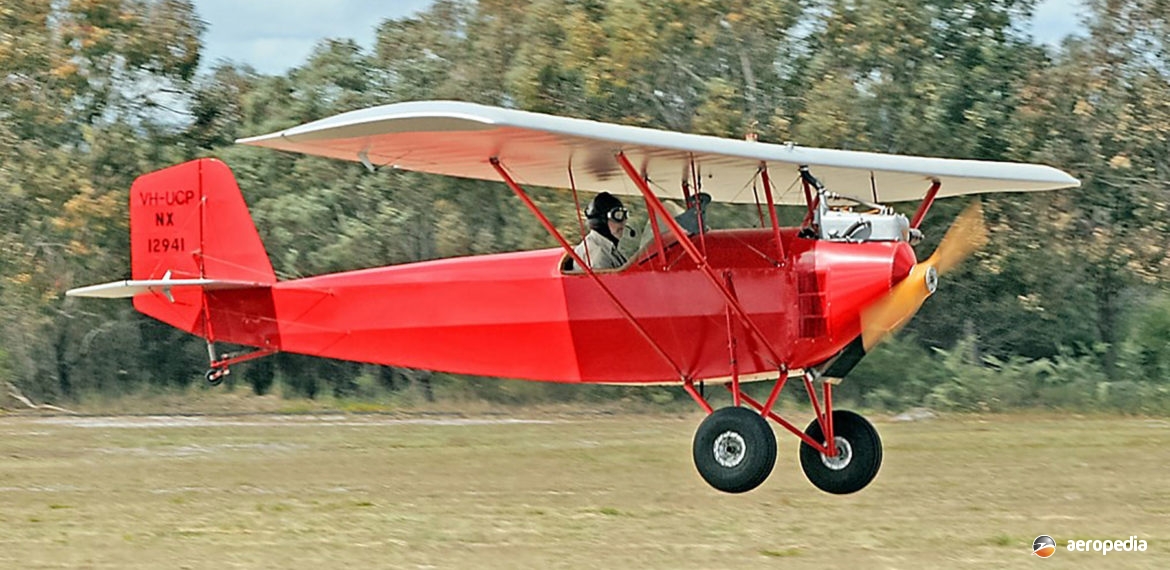Photograph:
Pietenpol Sky Scout VH-UCP / NX12941 (c/n 12) at Serpentine, WA (Bert Filippi)
Country of origin:
United States of America
Description:
Single-seat light parasol-wing sport aircraft
Power Plant:
One converted 15 kw (20 hp) c0nverted Ford Model T four-cylinder in-line engine
Specifications:
- Wingspan: 8.32 m (27 ft 3 in)
- Length: 4.96 m (16 ft 3 in)
- Height: 1.98 m (6 ft 5 in)
- Wing chord: 1.52 m (5 ft)
- Wing area: 12.54 m² (135 sq ft)
- Max speed: 100 km/h (62 mph)
- Cruising speed: 89 km/h (55 mph)
- Stalling speed: 56 km/h (35 mph)
- Take-off ground roll: 46 m (150 ft)
- Landing ground roll: 76 m (250 ft)
- Initial rate of climb with light load: 152 m (500 ft/min)
- Initial rate of climb with full load: 61 m (200 ft/min)
- Empty weight: 236 kg (520 lb)
- Loaded weight: 452 kg (995 lb)
History:
The Sky Scout was designed by Bernard Pietenpol in the 1920s and was intended for home construction by the amateur builder using readily available materials, ie wood and fabric, and using a 15 kw (20 hp) Ford Model T or 30 kw (40 hp) Model A engine as a power plant. The Sky Scout with the Model T Ford engine was a single-seat aircraft built in 1931 but the power limitations of the engine were quite severe. With the advent of the more powerful Model A Ford engine in 1932, this was more commonly used. American records indicate only a few Model A powered Scouts were built, the original prototype and a couple of replicas. The Sky Scout has several structural and dimensional differences, being developed by Mr Pietenpol as a completely new design.
A replica was built in the United States and first flew in 1972 powered by a converted Chevrolet Vega engine but eventually this was replaced by a Model A engine so it would be an exact replica of the original, being flown at Blakesburg in Iowa in 1977. Plans for the Sky Scout were published in magazines in the 1930s and it seems construction of a few examples commenced in Australia.
One machine was built before World War II and is believed to have done some flying in north-western New South Wales but was never registered. It was powered by a Salmson radial engine and was named Miss Mogal. This aircraft survives and is on display at the Power House Museum in Tamworth, NSW.
Another was built by Messrs Ron Lewis and Seddon Williams in the 1930s at Burwood, VIC. When they were young teenagers they commenced construction of a Sky Scout and fitted it with a converted Ford Model T four-cylinder engine. It is known the fuselage and tailplane were completed at the time. Lack of finance meant the aircraft was never completed. Mr Lewis in the 1990s constructed a replica of the Duigan Biplane.
The type has become popular in recent years and a number of examples have been built around the world using either Rotax engines or Chevrolet Corvair engines. One aircraft imported to Western Australia by Bert Filippi, is the second Sky Scout built in 1934 by Bernard Pietenpol at Cherry Grove in Minnesota, being a Model B4A1. It was the first of the type with a Ford Model A engine and was flown for the first time on 25 June 1932. Over the years it has had many owners and was damaged on a couple of occasions before being restored by Forrest Lovely between 1966 and 1970. At one stage it was displayed at the EAA Museum at Oshkosh in Wisconsin. It arrived in Western Australia in 2005, was restored, became VH-UCP (c/n 12 – ex N12941) and is flown regularly from Serpentine.
Plans for the Sky Scout were published in American Flying and Glider Manual and using these plans construction of a number of these aircraft commenced in Australia but it would appear only a few were completed.

